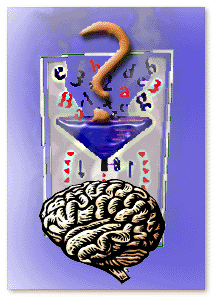 Interpretation is where we get to participate in our surrounding realm. To zoom in on our research priorities and delve into our thesis topic we must find valid sources and add our unique interpretation. Creativity matters too—no professor much enjoys reading the same tired tropes and allegories over and over. To further creative ends, no distant relation of loose associations is immune to the fun times associated with analysis. The Latin base of the word literally means to cut again; the linguistic parallel is in genetic biology, where our lysosomes function to cut strips, bacon-wise, of our chromosome material. Just as movies can metaphorically end up with many scenes lying on the editing room floor, a physical concept harkening back to the days of reel-to-reel projectors, the way to really discover a useful meaning in a situation or exhibit is to tease out what matters most. Superfluous dalliances aren’t worthless when they add intrigue, but in films, as in short stories, there ought to be nothing insignificant—no loose threads to distract from the golden thread tying the whole garment together. As when carding raw wool for a homespun sweater, we have to (as my Grandma used to do) literally pick out the feces so that only comfy bits remain – the better to provide pleasure to one’s body and mind. The idea in weaving is to create a fabric that holds together and expresses something thematic about the wearer; so too in an academic essay where personal ideas and public concepts combine into a believable story answering a turgid research hypothesis.
Interpretation is where we get to participate in our surrounding realm. To zoom in on our research priorities and delve into our thesis topic we must find valid sources and add our unique interpretation. Creativity matters too—no professor much enjoys reading the same tired tropes and allegories over and over. To further creative ends, no distant relation of loose associations is immune to the fun times associated with analysis. The Latin base of the word literally means to cut again; the linguistic parallel is in genetic biology, where our lysosomes function to cut strips, bacon-wise, of our chromosome material. Just as movies can metaphorically end up with many scenes lying on the editing room floor, a physical concept harkening back to the days of reel-to-reel projectors, the way to really discover a useful meaning in a situation or exhibit is to tease out what matters most. Superfluous dalliances aren’t worthless when they add intrigue, but in films, as in short stories, there ought to be nothing insignificant—no loose threads to distract from the golden thread tying the whole garment together. As when carding raw wool for a homespun sweater, we have to (as my Grandma used to do) literally pick out the feces so that only comfy bits remain – the better to provide pleasure to one’s body and mind. The idea in weaving is to create a fabric that holds together and expresses something thematic about the wearer; so too in an academic essay where personal ideas and public concepts combine into a believable story answering a turgid research hypothesis.
Novels entice viewers with the promise provided by the mystical arc of the narrative that seems to say believe in me, the storyteller, and I shall provide you with a happy ending. Sociological reality is quite different from the pat just-so fables of fiction; here we enter an arid landscape of facts and quotes, embellished with style and expression more than a plot line. Trail-blazing with a compass is the nature of research whereas creative writing is more about laying out a parkland and then studiously outlining trails and attractions. In both instances of writing we need to sort out our goals and priorities. The social sciences are especially adept at deploying typologies and categories, the better to make sense of the messy realm of social relations. Facts and people are plunked into slots like the game of Plinko on the TV game show The Price is Right – a show that traditionally ends each episode with Bob Barker’s rejoinder to remember to spay and neuter your pets. The notion of a single summary sentence, a tie that binds the whole bundle of facts and meanings together, goes way back into deep history. In 145 BCE the North African city of Carthage was the “richest city in the world” and had engaged in several wars with the protean Roman Empire. A Senator named Cato the Censor summarized the situation:
“Who are the ones who have often violated the treaty? Who are the ones who have waged war most cruelly? Who are the ones who have ravaged Italy? The Carthaginians. Who are the ones who demand forgiveness? The Carthaginians. See then how it would suit them to get what they want.”
Then, as at the end of each of his speeches, Cato shouted a coda that became a mantra for Roman foreign policy at the time: “Carthage must be destroyed!” The Senate would then erupt in approval. Regrettably we see ingrained animosity in today’s history of the Middle East: a theme of mutual conflict the likes of which drive fictional tales. Both sides see themselves as the protagonist, the rightful heir of the mantle of hero of the land. Muslim culture tends to adhere to a belief that once a land converts to Islam this land is perpetually the property of the Muslim world – a bit like finders-keeper. An academic named Dr. Ali Daghi, Secretary-General of the International Muslim Scholars, wrote: “There is a consensus among Muslims, in the past and present, that if an Islamic land is occupied, then its inhabitants must declare jihad until it is liberated from the occupiers.” This so-called consensus is problematic and challenged but does have historical truth to it, a bit like other colonial myths about bringing assorted salvations to Indigenous people, perhaps. Meanwhile, Israel believes that the land they occupy is an exclusive gift to them from God as a reward for their loyalty down through history. Plus, after 6 million Jews were murdered in the Holocaust after Hitler allied with several Arab leaders, countries of the world thought they deserved a safe space to call home, even if it came at the expense of the land’s contemporary occupants. So much for that classic Woody Guthrie tune ‘This Land is Your Land, This Land is My Land’.
Like all stories with their prequels and sequels, the current conflict is part of a humongous canvas that stretches back a millennium and a half since the time of Muhammad (570-632 C.E.). During the early centuries of Islam, their conquered lands spread all across southern Europe and Northern Africa. Their onward march of conquest was finally halted on the banks of the Danube River outside of Vienna. Muslim troops had laid siege to the city for some time before they city was rescued by a neighbouring Polish Prince named Sobieski (better known nowadays for the vodka brand bearing his name),
The collective loss of these lands as they were reclaimed by the Christian West has, some say, come to be symbolized in a nutshell by the Palestinian flag and the Palestinian’s struggle to achieve affluent nationhood since they were granted that right by the UN in 1947 simultaneously with Israel (history.com). The singular expression of a collective concept or sentiment is called metonymy; a typical metonymic reference is the phrase all hands on deck. Not only sailor’s hands are implicated but the hands symbolize the whole of the sailor’s brains, brawns, purpose, and mystique—extended, of course, to any situation requiring fast and decisive action. Likewise, brands seek to attach a plethora of meanings, statuses, and promotions to their corporate logos. Wendy’s fast food famously has the word MOM subtly drawn into the lady’s face in their logo, for instance. Meanwhile, the online activist sect Anonymous utilizes a classic thespian theme with a horror movie twist, an image of a serial killer’s mask worn to disguise his nefarious identity that strikes fear into purported-protagonists.
The ominous way a single image or symbol or phrase references a larger contested terrain has a historical parallel closer to our oh-so-Anglo Canadian home. Under traditional land use rights in England anyone could graze their sheep and cattle on public lands. Anyone, that is, until Henry VIII brought about a wholesale privatization scheme as part of the country’s allegiance shifting from Roman Catholicism to an independent Anglican Church. Aristocratic landowners, Big Agriculture if you will, embarked on an incessant series of land grabs generally known as enclosures – a bit like if our Crown lands today were systematically handed out to private corporations or particular identity groups. At the time the stated purpose was to maximize wool production, thereby to increase the economic prestige of the Empire. Henry Moore, later imprisoned in the Tower of London before being divested of his noggin’, expressed a concern prevalent at the time: “Your sheep, that were wont to be so meek and tame, and so small eaters, now, as I hear say, become so great devourers, and so wild, that they eat up and swallow down the very men themselves.” Not literal men, but men’s livelihoods. Of course, it wasn’t the sheep’s fault—these humble domestic quadrupeds simply symbolized the larger process whereby industry and the still-hegemonic landed gentry were coming to increasingly dominate society.
While aggressive expansion in the textile industry meant more wool made it into people’s sweater drawer, the means of its production was changed as well. An older putting-out system, where homebased artisans made as much product as they could and then laid it out for the owner to pick up, had given much latitude to workers. Each week they’d sell their wares to The Man, get paid, and party it up for a couple days. A similar Canadian process happened around Vancouver in the early days of logging: loggers would spend days out in the bush felling lumber and then return to the city for a weekend of carousing. What comes to symbolize a given epoch’s concerns and contradictions is only the tip of the iceberg; to this day a plaid sweater appears as a metonymy for rugged loggers, outdoorspeople, and coureur des bois, even as much of the history and traditions of the industry remains cloaked in mystery. Marketing, after all, depends on accessing our unconscious values and predilections without too many fuddy details clogging up the simple path between our mind and our wallet. It with this need to express with a single thesis statement a wide range of realities that we approach academic writing.
References
Cato, (146 BCE). Yale University. Retrieved from https://gsp.yale.edu/sites/default/files/first_genocide.pdf
Daghi, Dr. A. and Toameh, K.A. (2024) Quote and context summaries retrieved from:
https://sunnah.com/muslim:2922
https://www.gatestoneinstitute.org/biography/Khaled+Abu+Toameh
and
http://seminarygal.com/sin-and-hostility-advent-14-2023/
History.com. (2020/2024). ‘This Day in History 1947: UN Votes For Partition of Palestine’.
Moore, T. (1516). Utopia. Retrieved from https://www.history.com/this-day-in-history/u-n-votes-for-partition-of-palestine
https://www.oxfordreference.com/display/10.1093/acref/9780191826719.001.0001/q-oro-ed4-00007634

